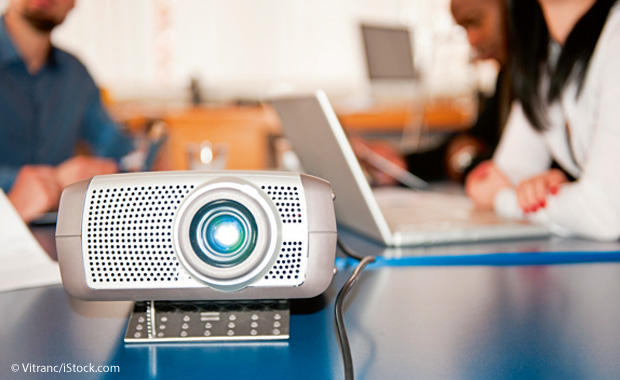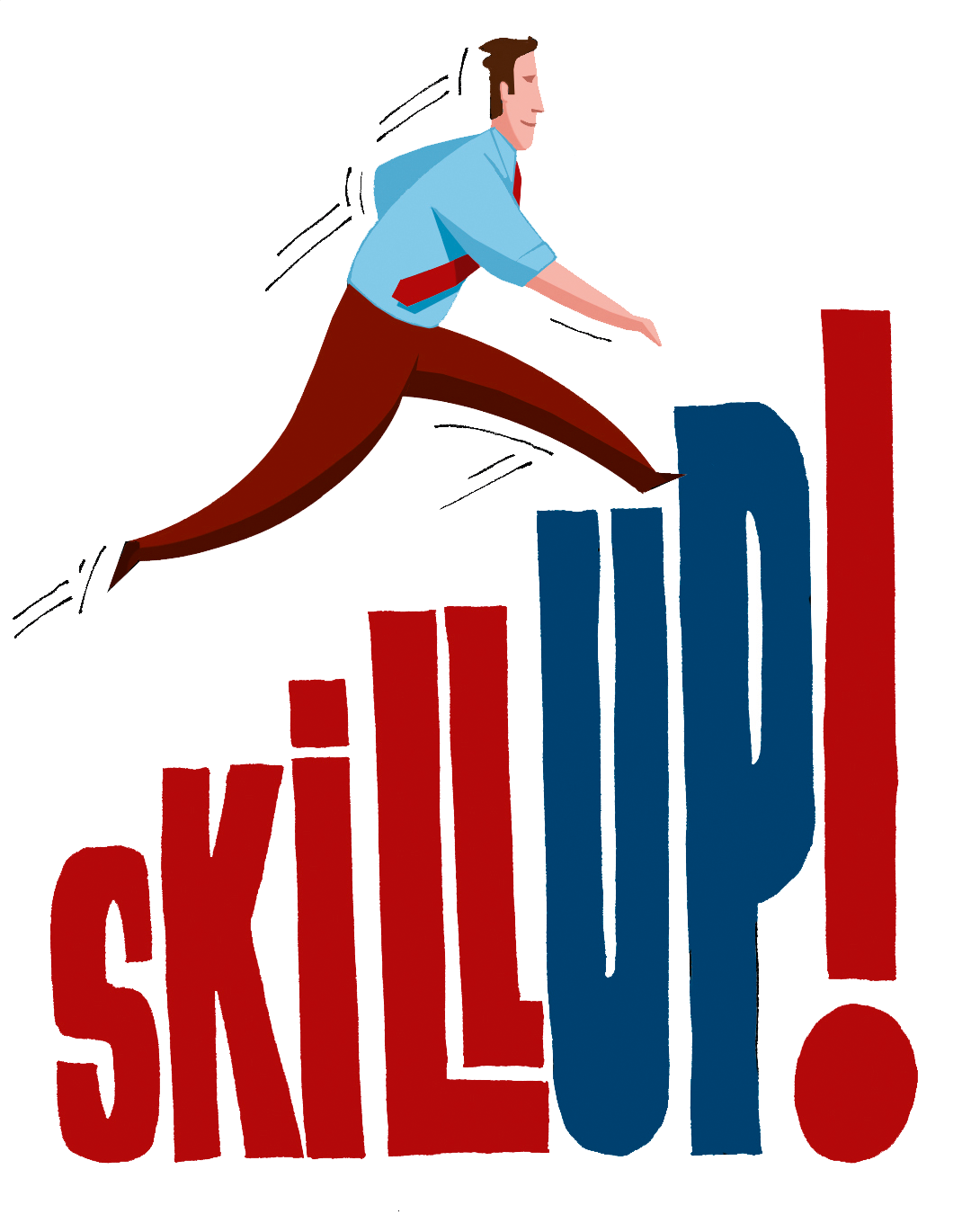Even for those who speak English as their native language, giving a presentation is a challenge. Naturally, this task becomes significantly harder for learners of the English language. In order to feel confident in front of your audience, you should therefore put a lot of work into the preparation of your presentation. You should also make sure that you are confident using business English and that you are not only equipped with the vocabulary and phrases that you will need during your presentation, but also with those needed to lead a discussion and deal with problems or interruptions from the audience.
Since it is often most efficient to learn English words and phrases in context, we’ve put together a sample English presentation in a business context. To save you some time, we have decided to just focus on excerpts from the presentation. Each example focuses on a specific topic, such as the introduction of your presentation, dealing with questions from the audience, presenting charts and so on. Below these example sections, you’ll find useful English phrases taken from our presentation. Many of them will come in handy for your next presentation.
We have also included a few general tips on presentations that apply to presentations given in any language, not just presentations in English.

First part of the English sample presentation: introduction and structure
Imagine the following context for this presentation: Lyndon Sykes, CEO of Cornmill Industries, is addressing the media and presenting his company’s latest results in English.
1. Opening statements at the start of the presentation
Facilitator: Good morning everyone and welcome to Cornmill Industries. In this presentation, we will be looking at the company’s annual results. I would now like to introduce Lyndon Sykes, CEO of Cornmill Industries.
Lyndon: Hello! Before we get down to business, let me kick off by giving you a quick rundown of how today’s briefing will work. I’m going to start with some highlights from last year.
Then, I’ll hand over to Tricia Hancock, head of sales and marketing. In the second part of our presentation, she will briefly say a few words about our latest social media campaign. Next, Angus Finch, our head of R&D, will give you an overview of some of the work we’re doing to reduce our carbon footprint and go even greener than we are already.
Finally, you’ll hear from Stuart Dixon, our CFO, who is going to present the key financials.
We’ll have plenty of time for a Q&A session at the end of the presentation, so unless your question really can’t wait, may I ask you to save any questions till then and not interrupt us in full flow? That would be much appreciated.
Phrases you can use for the introduction and organizational details in your English presentation
- Good morning everyone and welcome to...
- I would now like to introduce...
- Hello! Before we get down to business, let me...
- Let me kick off this presentation by giving you a quick rundown of...
- I’m going to start the presentation with...
- Then I’ll hand over to...
- She will briefly say a few words about...
- Next, Angus Finch will give you an overview of...
- At the end of the presentation, you’ll hear from Stuart Dixon , who is going to present...
- We’ll have plenty of time for a Q&A session at the end of the presentation.
- I’m now going to hand you back to...
- There will be a live online Q&A session...
2. Smooth transitions within the presentation
Lyndon: Right, in a nutshell, in the current competitive environment this is the situation the company finds itself in. Let’s now turn to the outlook for the next three years. In a moment, I’m going to show you a slide with a summary of the main concerns our customers expressed last year. But before I do, can I ask you to quickly have a look at this slide? It gives you an excellent overview of last year's business highlights.
English phrases for transitions between the sections of a presentation
- Let’s now turn to...
- In a moment, I’m going to show you a slide with...
- But before I do, can I ask you to...
- Let me just show you...
- So, that’s all I want to say about...
- Before we round off this segment, I’d like to present...
- I’m now going to talk you through...
- I’ll start the presentation with... before going on with...
- Let’s now move on to...
- This brings me to...
- As I’m sure you’ll have read in the press...

3. Technical problems during the presentation
Lyndon: Let me just show you... Oh! What’s this? No visuals! Do we have a technician handy?
Technician: Sorry, Mr Sykes, have you checked that your projector is plugged into the right port? Let me see. No, it isn’t. Just switch it over and it should work.
Lyndon: That’s better, thank you. Sorry about that, ladies and gentlemen. Oh, and while you’re here, could you lower the blinds a bit more for me? Thanks.
English phrases that help to deal with technical problems during a presentation
- Do we have a technician handy?
- Have you checked that... ?
- Could you lower the blinds a bit more for me?

Second part of the English sample presentation: audience questions
In the next part of the presentation, head of R&D Angus Finch and marketing officer Tricia Hancock show key developments in their divisions and answer questions from the audience.
4. Dealing with an interruption during the presentation
Angus: So, that’s all I want to say about the new developments... Yes, sir? Is that a question?
Audience member: Sorry to interrupt, Mr Finch, but do you mind if I ask you a question at this point in the presentation?
Angus: Not at all. Go ahead!
Audience member: I’d just like to ask about your plans for dealing with the carbon emissions levy for next year. Do you... ?
Angus: I’ll just cut you off there, if I may. I’d rather my colleague Stuart answered any financial questions. Would you mind tabling your question for now?
[...]
Angus: Before we round off this segment, I’d like to present some interim test results from our new sealants division. We are really proud of these, but they’re hot off the press so please bear with me. And it goes without saying that this might get technical, so I’d be grateful if you saved any questions until the end. Thanks.

Presentation tip: take control
It is your presentation, so you make the rules. By announcing what you want to happen at the beginning, you let your audience know where they stand so that nobody risks speaking out of turn.
5. Inviting questions during the presentation
Tricia: I’m now going to talk you through our latest marketing campaign. If you have any comments, feel free to stop me at any time during the presentation: I’d be delighted to hear them. And I’ll do my best to answer any questions you have.
I’ll start with our new print media campaign before going on to our social media activities.
[...]
Tricia: Fine, so that’s all I want to say about Cornmill’s social media presence. Thank you all for the lively discussion this afternoon. Oh, sorry? Is that one last question?
Audience member: Excuse me. As a marketing expert, what do you think about fake news? Should we be worried? Aren’t you in some way responsible?
Tricia: I’m sorry, I’m not quite sure what you mean. Would you mind repeating the question?

Presentation tip: keep calm and stay polite
When handling questions or interruptions during a presentation, try to stay polite. The person asking the question just wants to know something and might not know their intervention is untimely. Don’t make them lose face by being abrupt or brusque.
English phrases for dealing with audience questions
Inviting questions during an English presentation
- Is that a question?
- Go ahead!
- If you have any comments, feel free to stop me at any time during the presentation.
- I’ll do my best to answer any questions you have. Is that one last question?
- Are there any more questions or points?
Refusing questions during an English presentation
- May I ask you to save any questions until the end of the presentation?
- I’d rather ... answered any financial questions.
- Would you mind tabling your question for now?
- I’d be grateful if you saved any questions until the end of the presentation.
- Forgive me if I don’t go into too much detail.
- Perhaps ... can give you some more information about this.
Diplomatic interruptions during an English presentation
- I’ll just cut you off there, if I may...
- Sorry to interrupt, but do you mind if I ask you a question?
Asking for a question to be repeated during an English presentation
- I’m not quite sure what you mean. Would you mind repeating the question?

Third part of the English sample presentation: talking about graphs and bad news
In the third part of the example presentation, CFO Stuart Dixon presents the financial results and talks about problems with data security.
6. Talking about graphs and charts in the presentation
Stuart: Right, if there are no more questions about that section, let’s now move onto the figures for the last two quarters. This graph shows the like-for-like growth we have seen on last year very well. As you’ll notice, sales had already picked up in the first quarter, but they absolutely rocketed in the second. We put this down to customers having more disposable income.
English phrases to refer to graphs and charts in a presentation
- It gives you an excellent overview of...
- I’d like to present...
- This graph shows ... very well.
- As you’ll notice...
7. Handling bad news
Stuart: This brings me to our international operations. As I’m sure you’ll have read in the press, we have had some issues with data security at our outsourced customer service centre. I’m afraid some of the controls and checks weren’t as robust as we would have liked. Forgive me if I don’t go into too much detail in this presentation, but take it from me, things have improved since we put in a new management team. Basically, it was down to teething problems and a misinterpretation of company guidelines. Perhaps Lyndon can give you some more information about this when I hand back to him in a moment.
Useful English phrases for apologizing in a presentation
- I’m afraid...
- Forgive me if...
- Sorry about that, ladies and gentlemen.
- Sorry to interrupt,...
- Excuse me.
Fourth part of the English example presentation: the conclusion
Angus and Lyndon are coming to the conclusion of their presentations and winding up the proceedings.
8. Wrapping up the presentation
Angus: So, ladies and gentlemen, I think that covers most of the questions that you raised during my presentation. Are there any more questions or points? No? Then let’s call it a day and wrap this section up. I’m now going to hand you back to Lyndon, who will say a few closing words.

Presentation tip: practice makes perfect
Rehearse your presentation with an English-speaking friend or colleague. Ask them to interrupt you and to ask questions. Don’t always begin at the introduction; practise starting halfway through, with the conclusion or choose a slide at random and begin explaining it.
9. Final remarks and closing
Lyndon: Thank you, Angus. Thanks also to Stuart and Tricia for their contributions. I’d like to conclude by thanking everyone for their contributions today and for your interest in Cornmill Industries. Don’t forget that all today’s presentations have been streamed on our website and there will be a live online Q&A session immediately after we finish here if any of you have any further questions.
So, all that remains is for me to thank you once again for coming. Thank you and goodbye.
English phrases for the conclusion of a presentation
- So, that’s all I want to say about...
- Thank you all for the lively discussion.
- I think that covers most of the questions.
- Then let’s call it a day.
- Let’s wrap this section up.
- I’d like to conclude by thanking everyone for their contributions today.
- Don’t forget that...
- All that remains is for me to thank you once again for coming.
Tips for giving English presentations
Would you like get more tips on how to prepare for a presentation and deliver a confident talk that won’t make your audience fall asleep? Our editor-in-chief Ian McMaster shares some secrets:



